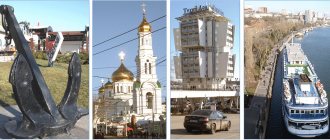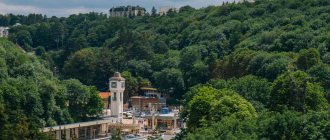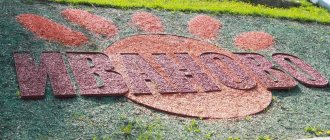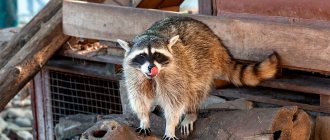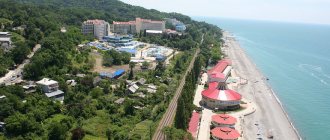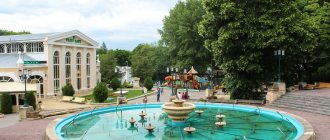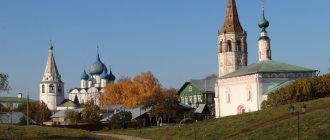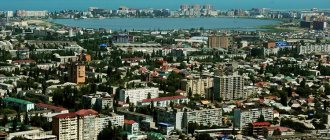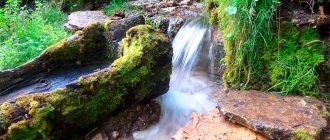Natural attractions
Many interesting locations in the city are tied to the Don River, on which it is located.
Levberdon
The left bank of the Don received such an unusual name among local residents. This is the new embankment of Rostov-on-Don, opened before the 2021 FIFA World Cup.
The recreational area stretches along the water for 10 km. The main area (more than 90%) is occupied by restaurants, night clubs, cafes, baths and recreation centers. This is where the central city beach is located, located just above the Voroshilovsky Bridge.
On the left bank of the Don, the Rostov Arena stadium with 45,000 seats was built for the World Cup, and a small park was laid out nearby. It has a children's playground with a safe rubber surface. For lovers of active recreation, cycling, rollerblading, and skateboarding are available on a special path. The territory has basketball, badminton and volleyball fields, as well as tennis courts.
Green Island
The Don river island has the shape of a triangle. It is called green because of the huge amount of vegetation. Poplar, ash, blackberries and much more grow here. There is a secluded wild beach on the sandy shore, and nearby there are several recreation centers: “Sperm whale”, “Emerald”, “Dream”.
Green Island is considered an anomalous zone by local residents. There are rumors that a flying saucer once landed on it. Allegedly, since then, many people have been lost “in three pines” and wander for a long time in search of the way back due to the fact that time is distorted.
You can get to the island only from April to November via a pontoon bridge, which is dismantled for the winter. Passage through it is free, but travel by car is paid.
Streets and architecture
The most interesting streets with iconic sights of Rostov-on-Don are located in the city center. The historical center flaunts ancient architecture. The beautiful appearance of Rostov-on-Don was formed by trading houses of merchants, classical buildings of museums and city administration, built in the 19th century.
Pushkinskaya street
One of the main streets of Rostov-on-Don stretches for almost 4 km. A relaxing atmosphere is created by walking paths surrounded by greenery, shady alleys, benches, sculptures in the form of balls and a monument to the Russian poet A.S. Pushkin.
Its unusual architectural appearance is given by ancient buildings of the late 19th – early 20th centuries: the apartment building of Vasily Kushnarev, the mansions of Pavel Kramer and Nikolai Paramonov. A small section of Pushkinskaya Street is reserved for a park area, in which there are several cafes, restaurants and shops. During the hot season, fountains gush here.
At the intersection with Nakhichevan Avenue there is a composition “Lyre” with three musical instruments on a low platform from which water gushes. Another such structure with light and sound accompaniment is located near the Don State Public Library.
Bolshaya Sadovaya
The central street of Rostov-on-Don is one of the earliest in the city. Its construction began in the middle of the 19th century. Sadovaya is compared to Nevsky Prospekt in St. Petersburg, and one of the sites with old houses is called the local Broadway.
Monuments of civil architecture are concentrated here, for example, the three-story mansion of Argutinsky-Dolgorukov with Baroque elements: sandriks, attics, frames and stucco.
The building of the former Volzhsko-Kama Bank, built in the Art Nouveau style, is also interesting on Sadovaya Street. The facade is decorated with masks, arches, attics, and stucco. There are huge windows on the second floor, and small balconies made of metal on the third. Today the house houses the Palace of Children and Youth Creativity.
Trading house Gench-Ogluev
The apartment building of the merchant Gench-Ogluev was built in 1883 and became the first “high-rise” in the city. External and internal decoration is predominantly in an eclectic style.
Excluding the attic and basement, the building has 3 floors. The structure ends with a multi-pitched roof with a superstructure, which after the Great Patriotic War was restored in a modified form: the tent on the tower was reduced, the spire was removed and dormer windows were made.
The main facade of the trading house is decorated in the Baroque spirit. The large windows on the ground floor, designed as shop windows, catch your eye. On the second and third floors the openings are rectangular, in some places they are supplemented with sandstones.
There are two entrances to the building: one is made from the facade and has the shape of an arch, and the other is located on a beveled corner - under a two-tier bay window.
City Council building
The house was built in 1899 for a meeting of the local council. During Soviet times, the regional committee of the CPSU worked there, and today the Rostov City Hall is located here.
The building is designed in the spirit of eclecticism with Baroque elements: stucco, masks on the facade with the image of ancient goddesses, capitals with women's faces, caryatids under the balconies.
The City Council building has 4 floors, and above them there are small domes. They were returned to their place during reconstruction. A characteristic feature of the house is the windows of different sizes and shapes: rectangular, round, square.
Only City Hall employees are allowed inside the City Council building - you can only admire it from the outside.
River Station
On the territory of the river station there is a two-story building built in 1977 to serve passengers of cruise ships arriving in Rostov-on-Don. In its shape, it itself resembles a river boat - with galleries and transitional ramps. The terminal is made primarily of concrete and glass.
The complex includes the former 11-story Anchor Hotel, adjacent to the passenger building. As conceived by the authors of the project, it was supposed to resemble a captain's bridge for observing the river. Now its premises are rented out to restaurants, shops and travel agencies.
From Rostov, cruise ships depart to Yeisk, Astrakhan, Samara, Volgograd and Moscow.
Rostov Regional Museum of Local Lore
Rostov Regional Museum of Local Lore
Rostov-on-Don
The history of the Rostov Regional Museum of Local History began in 1910. The first exhibition included personal belongings of the Russian writer Daniil Mordovtsev, silver cups of the outstanding commander Alexander Suvorov, and the cocked hat and sword of the Rostov mayor of the mid-19th century, Andrei Baikov.
Today in the Museum of Local History you can get acquainted with the history of the Don land from antiquity to the present day. Here you can see ancient gold coins, silver “scales” from the time of Ivan the Terrible, and copper coins with the monograms of Catherine II. The ethnographic collection includes festive fur coats of uniquely cut Don Cossack women, pearl-embroidered kichkas and embroidered shirts.
Entertainment
The city offers a lot of entertainment, including for extreme sports enthusiasts. Various land and water attractions are quite popular.
Ferris wheel "One Sky"
The Rostov Ferris Wheel is the third highest in the world - it rises 65 m above the ground. It offers an overview of the city within a radius of 25 km.
All 30 cabins are glazed, there are tables and soft sofas inside, designed for 6 people. The attraction can accommodate up to 180 visitors at a time.
The Ferris wheel operates all year round in any weather. Each cabin is equipped with air conditioning to cool the air in summer and heat it in winter. The attraction also has more comfortable seats - with leather chairs and music. They are often chosen by young people for romantic dates.
The lowest ticket price is on weekdays from 10.00 to 12.00. Children under 6 years old are admitted free of charge.
Water park "H2O"
The water and health complex is located on an area of 25,000 square meters. m and consists of three levels:
- On the ground floor there is a large swimming pool with imitation waves and a smooth entry into the water, Tsunami and Slow River attractions, grottoes, and a playground for children. Here you can also buy drinks in two bars.
- The second level of the water park is completely dedicated to a relaxation area: massage rooms, spa salons, cafes.
- On the third floor there is a cafe, a bathhouse, and classic swimming pools - summer and all-season.
The water park has 8 indoor and outdoor water slides. For thrill-seekers, there is the Magic Hole attraction with numerous twists and turns.
Old bazaar
This is what people call the Central Market of Rostov-on-Don, which is located on Budenovsky Prospekt. The first shopping arcades appeared here back in the 1820s, and now it is the largest market in southern Russia.
On the territory of the bazaar there are covered food areas where they sell meat, eggs, milk, vegetables and fruits, cereals, and spices. Clothes, shoes, and haberdashery are sold in the clothing area.
Market prices are quite high in the city. This is due to the expensive rental of places. But many sellers are willing to bargain and make good concessions. Trade at the market also goes on at night: products are sold in bulk at almost half the price.
Restaurant "Iveria"
The Georgian restaurant has two rooms. The main room can accommodate up to 120 people, and the veranda can accommodate 20 guests. Another 100 seats are provided under the summer tent on the street. The interior of the establishment is designed in a classic style.
The decoration of “Iveria” includes brick. Small paintings hang on the walls. The rooms are furnished with wooden tables, chairs and soft sofas. The emphasis in the interior is on muted shades.
The Iveria restaurant offers not only Georgian dishes, but also European cuisine. The menu includes first and second courses, appetizers, sauces, salads, and desserts. But people come here specifically for the national Georgian pastries: khachapuri, mchadi, chvishtari, lavash. In addition, the establishment offers a huge selection of meat, fish and vegetables cooked on the grill.
The check for lunch at Iveria ranges from 1000–1700 rubles.
Rostov Museum of Cosmonautics
Rostov Museum of Cosmonautics
Rostov-on-Don
The Rostov Museum of Cosmonautics opened in 2009 - the first excursion for visitors was conducted by pilot-cosmonaut, Hero of Russia Yuri Usachev. In the museum you can see samples of space technology, spacesuits, models of communication satellites and food that feeds the crew of the spacecraft.
The main exhibit of the museum is a unique descent module that was used in the expedition to the International Space Station. The device has been converted into a simulator - it allows you to simulate the process of maneuvering and mooring a ship in space. This is the only operating exhibit of its kind in the south of Russia.
Religious buildings and war memorials
Rostov-on-Don is a stronghold of Orthodoxy and the diocesan center of the Don Metropolis. It is not surprising that the city has more than 50 monasteries, temples, churches and chapels.
However, fierce battles with the German invaders took place in the same city. Therefore, after the war, there remained mass graves and several large memorials in honor of the fallen soldiers.
Iversky Convent
The history of the convent dates back to 1903. It was then that a community was established on its territory: outbuildings, a church and a sister’s building were erected here. Today, 35 novices live in cell buildings that appeared a century later.
The revival of the monastery was marked by the restoration of the Lower Church of St. Demetrius, Metropolitan of Rostov, and the Upper Church, dedicated to the Iveron Icon of the Mother of God. The domes of the structure are covered with gold and are visible from afar. The renovated buildings also received new iconostases. In 2021, the community built the Holy Trinity Cathedral for 1000 parishioners, designed in the style of ancient Russian architecture.
Cathedral of the Nativity of the Blessed Virgin Mary
The main church of the Rostov diocese was built in 1860 on the site of a previously dilapidated stone church with wooden domes. It has the shape of a cross and five large domes. The architects adhered to the Russian-Byzantine style in design. Inside there is a three-level iconostasis in the form of a chapel with a tent and a dome.
The ensemble complements the smaller church in the name of John the Baptist, in which church services are held every day. The courtyard houses the office, diocesan commissions and departments, and shops with spiritual literature and church items.
The complex also includes the Church of St. Nicholas - it was opened in a former bell tower.
Zmievskaya beam
The largest mass grave in Russia of people killed during the Holocaust. Mostly Jews and Soviet prisoners of war who were shot by the Nazis in 1942 are buried here.
is a sculpture installed in the depths of the beam. The key figure of the composition is a female figure who symbolized the Motherland and encouraged the city residents to fight the Nazis.
The park was created on slopes covered with grass and low ornamental trees. On one of the hills there is a main entrance - through the Funeral Hall. There is also an observation deck here, which offers a beautiful panorama of the city. Nearby the Alley of Sorrows descends, which leads to the Eternal Flame.
Kumzhenskaya Grove
At the confluence of the Don and the Dead Donets, the Kumzhenskaya Grove memorial complex was created. It was opened in the Zheleznodorozhny district of the city in honor of the soldiers who defended the city from German invaders during the Great Patriotic War. The composition includes a mass grave, 4 steles and monuments.
The ensemble opens with a monument to a Soviet soldier on a pedestal, installed right at the entrance. In 2005, a time capsule was laid underneath it, which is planned to be opened in 40 years.
The main sculpture of the complex is “Storm”. She embodies the images of attacking soldiers of the Soviet army. Above them rises a 20-meter arrow, which resembles the arrow on military maps and shows the soldiers where to advance.
Restorer named time
Rarely, there are buildings with well-preserved pre-revolutionary lime plaster, for example, a residential building at 4, 26th Line.
“These are the kind of buildings that, in an amicable way, should not be touched at all,” Bocharnikov is sure. – How can this building be treated humanely? Restore the base, since this is the lower part and it gets dirty and cracked the most, restore the lost parts between the windows, insert decent frames, carefully patch up the cornice on top. Renew the front entrance: what is valuable is that the original doors have been preserved here, even the original relief glass has survived. And do not paint or smear anything in order to preserve the perfectly clear reliefs, the smoothness of the plaster and its noble vintage appearance. No amount of art can imitate such a texture; it will look like a prop. But here time did everything itself.
We approach the corner building on Gazetny, part of the complex of the famous Wrangel household.
One house is still awaiting restoration, and the other, the corner one, has already been renovated. True, they chose a controversial green shade for it - this was “prescribed” for the builders by the Ministry of Culture.
The fourth number in our rating is the former Vasilenko bell factory on the corner of Pushkinskaya and Gazetny. Initially, there was a Burtsev factory there, which made building ceramics: pipes, tiles for stoves and refractory bricks. Then Burtsev sold the entire business to Vasilenko.
Now the building houses the military prosecutor's office. It was repaired under the overhaul program and did a decent job. As in the House with Owls, the builders skillfully restored the plaster - they made it smooth and applied it evenly.
Cultural attractions
Rostov-on-Don is a large cultural center with different types of institutions. There are philharmonic societies, theaters, museums and folk art houses.
Drama Theater named after M. Gorky
The Rostov Academic Drama Theater occupies a building built in the 1930s and restored after the war. It is considered a masterpiece of constructivism, and its model is exhibited at the London Architecture Museum.
The shape of the building resembles a tractor, and the facade uses a lot of glass and granite.
The theater has three stages:
- large with 1165 seats,
- small for 300 spectators,
- experimental for 70 visitors.
They stage performances based on famous Russian and foreign classics: “The Fate of Man” by M. Sholokhov, “Woe from Wit” by A. Griboyedov, “Romeo and Juliet” by W. Shakespeare.
The cost of theater tickets depends on the performance and location - from 600 to 3000 rubles.
Palace of Culture "Rostselmash"
The modern cultural center was built in the post-war years next to the park and stadium. The three-story building was built of white stone. There are 8 tall columns with arches installed on the porch, and a staircase is located in the center, to the left and to the right of them. The front façade is complemented by sculptural bas-reliefs. There is a fountain in the square in front of the entrance.
The main hall has a ground floor and two balconies - it can accommodate 1000 people in total. Concerts and performances are staged here. A separate room with 300 seats is allocated for official events.
The Palace of Culture has its own dance and music groups, as well as theater studios for children and adults.
Museum of the North Caucasus Railway
The Railway Museum is a branch of JSC Russian Railways. It has been operating since 2003 and includes two locations. In the Palace of Culture of Railway Workers at the Rostov-Glavny station you can see exhibits highlighting the history of North Caucasus Railways: smaller versions of carriages and locomotives from different eras, illuminated panoramas, podiums and showcases.
open-air museum has been created with real exhibits : a heated carriage from the Second World War, a steam locomotive of the post-war years, tank and artillery tractors. All this is placed on the 1.9 km long tracks of the now inactive Gnilovskaya station.
Attractions for children
For children in Rostov-on-Don, attractions of various formats are available: related to entertainment, education and introducing them to the animal world.
Interactive Science Museum "Laboratorium"
The scientific and educational center offers children educational programs, vibrant shows and interesting excursions. The museum exhibits objects related to chemistry and physics. All items presented can be touched and used.
The main entertainment for young guests is conducting various experiments, for example, creating huge soap bubbles.
The museum occupies three floors, each of which is dedicated to a different science. In it you can make your own ice cream using an unusual recipe, get an answer to any question from the Tori robot, experiment with sounds, find yourself inside a book tower or go through a labyrinth with lasers.
Zoo
The Rostov Zoo was founded in 1927 and is one of the largest in Russia in terms of area - 57 hectares. It is home to more than 5,000 animals. Among them there are rare species listed in the International and Russian Red Book. The zoo participates in programs to preserve endangered species.
The park has an aquarium with fish, a terrarium with reptiles, amphibians and invertebrates. Mammals live in open and closed enclosures.
The living collection includes representatives of fauna from all over the world: crocodile, kangaroo, lion, polar bear, leopard, puma, camel, zebra, giraffe, elephant and many other animals.
Entrance fee to the zoo: for children from 5 to 10 years old – 100 rubles, for teenagers and adults – 350 rubles. If desired, you can book a sightseeing tour for 1000 rubles.
Toy railway
The Small North Caucasian Railway named after Yuri Gagarin began operating in 1940 in Ostrovsky Park (then it, of course, had a different name). The route is looped and is 4 km in total. It runs two trains with a diesel locomotive and a steam locomotive, which pull 3 and 8 cars. On their way they stop three times, including at Pobeda station.
The Russian Railways has a station on the platform named after. Viti Cherevichkina, and the control is located at the Solnechnaya stop. In a separate building there are actual ticket offices and control centers where passengers can apply for advice and tickets. a mini-museum with model railways on site
To work on a children's railway, a child needs to undergo training at a school within the organization. Classes are held 1-2 times a week in the format of lectures and games.
Interactive amusement park "Kidburg"
The entertainment complex was created to educate schoolchildren through role-playing games. In Kidburg, children can become adults for a while: get money for education, learn a profession, undergo a medical examination, get a work record book and get a job. Jobs are available for graduates at the post office, in the police and hospital, on a farm, in a bakery, and at a service station.
All children employed in the park receive a salary after working for 20-40 minutes and decide for themselves what to spend it on in a local store. Or you can put the money you earn in the bank. But, of course, this is all a game controlled by the guests themselves.
The park hosts classes in the animation studio and master classes. Birthday scenarios are developed for birthday people. This service is provided upon reservation and prepayment. There is a café and a souvenir shop on site, where you can buy books, educational games and various little things as souvenirs.
Youth Theater
The Theater for Young Spectators was created in 1930. The institution is located in a palace built in 1899. The house is decorated in a mixed style: classicism, renaissance, baroque. The second floor has a balcony with balusters on the sides, massive columns and a triangular crenellated pediment on top. The frieze is decorated with floral motifs.
The theater houses a small and a large stage. The main three-tier hall with 700 seats hosts concerts and performances for children. The repertoire of the Youth Theater consists of comedies, dramas, fairy tales of famous Russian and foreign writers and poets: I. Bunin, V. Mayakovsky, I. Goethe and many others.
And grandma is against it
In his opinion, a positive trend in the repair of facades of ancient buildings is still observed. Now, if the building is brick, the estimate will necessarily include cleaning, not plastering.
“True, the problem is that now it is not architects who decide what a century-old building should look like, but residents. There are times when experts recommend cleaning the house, and some grandmother from the second floor, who was set up by the same contractors from the Overhaul Fund, shouts that the building absolutely needs to be plastered. And according to the law, they must listen to grandma. And the overhaul system often takes advantage of this. After all, plastering suggests that less effort will be expended, and the earnings will be more,” our interlocutor regrets.
But there are good examples here too - the constructivist buildings on Nolnaya Street had to be plastered, experts met with the residents, convinced that this should not be done, and as a result the brick house was painted and a good color scheme was chosen. Paint on brickwork is, in fact, conservation, and in the future there is a chance to clear many historical facades of paint, but unfairly applied plaster with its hard adhesive layer will be much more difficult to remove and more destructive for ancient masonry. So it’s a shame that old atmospheric houses, such as the complex of houses of the Tramvayshchik residential complex on Pushkinskaya or the Mikoyan Shoe Factory residential complex on Budennovsky, have been “rolled up” in “bark beetle” forever, killing their historical appearance.
One day route around Rostov-on-Don
In 1 day you can explore the sights in the center of Rostov-on-Don near the embankment. To get to know the city comfortably, you should plan a route of maximum 5 km. For example, this one:
Embankment of the Don River
The pedestrian part is organized along the right bank of the Don. It starts near the business and ends at the pier of the Pier restaurant. The length of the embankment is 1.85 km.
The territory is decorated with sculptural compositions:
- "Grandfather Shchukar"
- "Cancer",
- "Fisherman",
- "Castle Tree"
- "Artist",
- "Captain Flint" and others.
The embankment's calling card is the Petrovsky light and music fountain . This is the only composition in the city without a swimming pool, in which jets of water shoot directly from the tiled two-level platform. The height and strength of the flow is constantly changing, which creates the effect of a dance.
Every year on the embankment there is a festival of the Don River, which is organized in its “honor”. The event includes performances by musicians and dancers, and various competitions.
Paramonovsky warehouses
If you walk 200 meters deep into the city from the monument “Border Guard of All Generations”, you will see the Paramonov warehouses. In the 19th century, tons of wheat were stored here and then transported to England. Maxim Gorky (then Alyosha Peshkov) worked as a loader in these warehouses.
Despite the status of a monument of federal significance, ruins remain of the former storage buildings, and the building is not protected. During its downtime, it lost windows, ceilings, and ceilings between two floors.
Now a pool with emerald water has naturally appeared inside, which is fed by underground springs. In summer you can swim here.
The Paramonov warehouses are fenced around the entire perimeter, but the gates are open and you can get inside freely.
Gorky Park
To get to the park from the Paramonov Warehouses, you need to move first along Voroshilovskaya Street and then along Bolshaya Sadovaya. You have to walk about 2 km.
The park is the oldest in Rostov-on-Don - it was laid out here in 1813. Walking areas are divided into two parts:
- The Upper Park has attractions, including a Ferris wheel. There is also a cafe and a stage for summer performances, festivals, competitions and concerts.
- The Lower Park has walking paths for walking and many plants have been planted. Here, every year, a flower carpet is created, which has no analogues in Russia. There are about 800 flower specimens per 1 square meter. Along the alleys there are artists who can immediately draw a portrait of anyone.
A chess and checkers pavilion and children's playgrounds are open in the park. The landscape is decorated with 7 thematic fountains: “Heron”, “Neptune”, “Lighthouse”, “Grotto”, “Eastern”, “Goldfish”, “Western”.
In Gorky Park you can observe the stars and other planets through the main and solar telescopes - in an observatory with an automatically extending dome.
Art Museum
The distance from Gorky Park to the Museum of Fine Arts is about 1 km. You need to get to the place through Bolshaya Sadovaya Street. The institution opened in 1938, and its collection was based on collections of local patrons and exhibits from leading museums in Russia: the Hermitage and the Tretyakov Gallery.
The two-story building that houses the museum is an architectural monument of the late 19th century and is widely known as the mansion of Apollo Dombrowski. It is made in a mixed style: with elements of Renaissance, Baroque, and Classicism. The façade is decorated with sculptures, pilasters, balusters, capitals and arched windows.
The museum has departments with paintings from the 19th and 20th centuries. A key place in the collections is occupied by works by Russian painters: Aivazovsky, Bryullov, Levitan, Repin. Also presented here are works by I. Mashkov, T. Teryaev and other lesser-known artists.
The institution operates an information and educational center where they show videos, conduct virtual excursions and organize games. The museum offers master classes in drawing and interactive activities with theater elements for adults and children.
Schoolchildren are offered lectures on various topics: “Stories about artists”, “The art of Western Europe and the Ancient World”, “Mythology in art”.
The merchant's house is in good hands
Among the five positive examples is the residential building of the merchant Rossalimo, built in the second half of the 19th century. The 140-year-old mansion is located on the corner of Donskoy Street and Gazetny Lane, opposite the already mentioned Wrangel household. According to the preparation program for the World Cup in 2017, the building fell into the hands of good builders.
Photo by Roman Bocharnikov
A lot has been done here wisely. The contractor went over budget. A shell rock relief is visible above the windows and doors; many details were lost, but they were restored. The estimate did not include such expenses for the restoration of lost elements, but the contractor assumed part of the costs. It’s a rare quality these days to prioritize a decent work result, rather than profit or savings.
“We were afraid that they would simplify everything again and remove architectural details. Fortunately, this did not happen. Moreover, the builders cleaned up the so-called Don masonry - alternating yellow and orange bricks, in some places even a funny pattern can be seen. The same contractor did part of Wrangel’s household,” explains the social activist.
